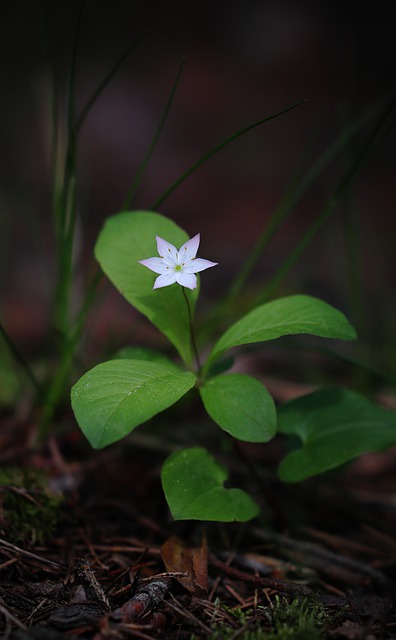 |  |  |   |  |
 |  |
In Latvia there is a European Chickweed Wintergreen (Trientalis europaea L.). Chickweed Wintergreen are perennial plants that do not exceed 20 cm in height. They have fine, erect stems, glabrous or sparsely pubescent with dark purple hairs. The rhizome is thin, thread-like, whitish, with rare brown inclusions, with many underground shoots and rubber-like extensions at the ends - on which new above-ground shoots are formed.
The lower leaves are arranged alternately, small 1-3, brownish, scaly. The leaves of the stem are arranged alternately, green, 1-1.5cm long, 0.5-0.8cm wide, inverted ovate or elliptic. The highest leaves can grow up to 7cm in length, forming a rosette of leaves at the top of the plant, some types with a finely toothed edge, wedge-shaped at the base on a short leaf stalk 1-3mm long. Petioles and leaves are sparsely covered with dark purple hairs on both sides.
The flowers have 5-9 petals, which grow to a maximum of 2 cm in diameter, they are snow-white or soft pink in color. Placed on upright, naked flower stalks, up to 6 cm high.
After flowering, it forms fruit - a rounded five-lobed button. On the other hand, only 10-25% of the fruits ripen. Inside the fruit, small, oval seeds, up to 1 mm long, almost black in color. The seeds ripen in July-August. The plant blooms from May to July.
Chickweed Wintergreen is not collected for further storage, but only fresh plants are used. Most widely, this plant is used in Chinese medicine. In folk medicine, the plant is harvested during its flowering.
The chemical composition of the plant has been little studied, it is known that the leaves and root of the plant contain saponins and the carbohydrate amyloid. Lactobacillus also contains vitamin C.
Medicinal significance
Official medicine does not use this plant in its research and treatment.
In folk medicine, the root is used as an emetic and diaphoretic agent. Externally, the decoction was used to treat wounds.
Chickweed Wintergreen is recommended as a wound-healing and anti-inflammatory agent for the treatment of panaritis, tumors, eye diseases and orally for the treatment of weakness, in case of malaria. The plant is also useful for the treatment of neoplasms, asthenia and diseases of the nervous system.
The plant is also successfully used to treat skin diseases, wounds and burns.
